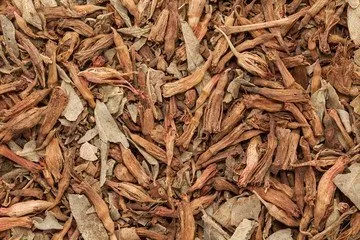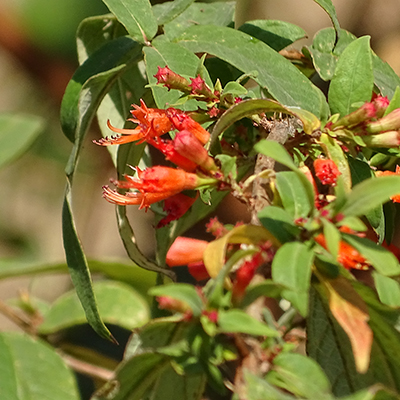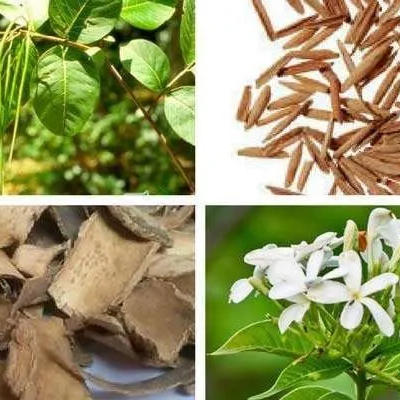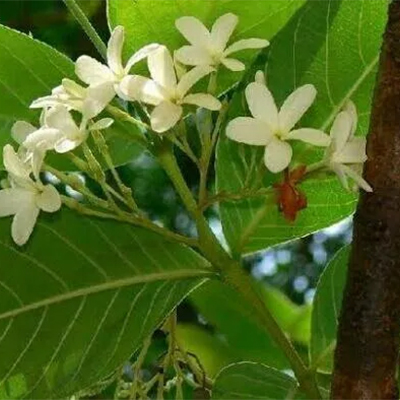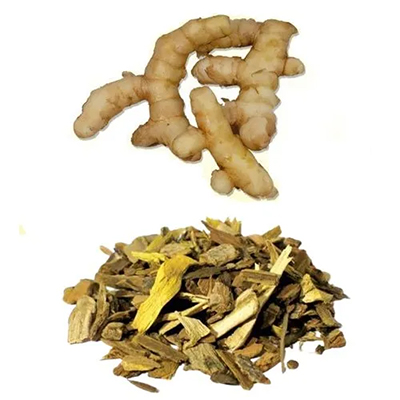On This Page
Dhataki: Backbone of Asava and Arishta
Introduction
In the Ayurvedic medicinal industries, Dhataki is a plant of high demand and its Pushpa (flowers) are highly valued in the Indian system of medicine. Dhataki botanically known as Woodfordia fruticosa is a long-live shrub of the Madhyantika (Mehndi) family i.e Lythraceae. As per Ayurvedic classical texts, it is the most famous fermentation product. Acharaya Charaka categorized it under Asava Yoni (fermentation product), hence it got synonyms like Madya Hetu and Madya Kara. Dhataki is also considered under Mutra Viranjniya and Pureesh Sangrahniya Mahakashaya by Acharaya Charaka. It is used in the preparation of various Asava and Arishta, that’s why it is considered the backbone of Asava and Arista. It is pungent and astringent in taste with cold potency. As per Ayurvedic classical texts, it exhibits various Karmas like Stambhana, Rakta Stambhana, and Sandhaniya. Rakta Pitta Shamaka, Mutra Virajaniya, Yonisravarodhaka, Kustha Ghana, Jvara Ghana, Daha Prasamana, Vranaropana, etc. Recent studies revealed that it consists of primary alkaloids like becogenin, gallic acid, ellagic acid, beta-sitosterol, tannins, sugar (glucose), ursolic acid, kaempferol, lawsone, octacosanol & meso inositol, ellagic acid, myricetin, etc due to which it exhibits anti-microbial, anti-inflammatory, anti-hyperglycemic, analgesic and immune- modulatory activity, etc.
Basonym of drug
दधाति तकितानि हसितानि रम्याणि पुष्पाणीति अथवा दधाति रक्षति शरीर मातिअंकरीति |
Flowers of Dhataki are very attractive, and it is also used as medicine.
Synonyms
- According to habitat
पार्वतीया – पार्वत्यप्रदेशे जाता |
The plant commonly grows in the hilly region.
सुभिक्षा- बाहुल्येनोपलभ्यमाना |
Dhataki grows abundantly and one plant yields a good quantity of flowers.
- According to morphology
धातुपुष्पी- धातु: गैरिकं, तद वर्णानि पुष्पाण्यस्या: |
Flowers of Dhataki are red like that red ochre.
वन्हिपुष्पा- वन्हिज्वालेव रक्तवर्णानि पुष्पाण्यस्या: |
The flowers are red like that of flame.
गुच्छापुष्पा- गुच्छेपुष्पाण्यस्या: |
Flowers occur in bunches.
बहुपुष्पिका- बहुनि पुष्पाण्यस्या: |
The Dhataki plant will have many flowers.
- According to properties and action
मदहेतु: – मदे अमिषवे हेतु: निमित्तम् |
Dhataki flowers are used to prepare alcoholic preparations.
मद्य वासिनी- मद्यं वासयितु शीलम अस्या: |
Dhataki flowers have the property of generating alcohol.
सिधु पुष्पी- सिधौ मद्ये पर्युक्तानी पुष्पाणया यस्य: |
Dhataki flowers are used in alcohol formation.
Regional names of Dhataki
- Fire flame bush, Woodfordia (English)
- Dhai, Dhaya (Hindi)
- Dhavadi (Gujarati)
- Dhalas (Marathi)
- Dhai (Bengali)
- Tamra Pushpi (Kannada)
- Tatiri Pushpi (Malayalam)
- Pulsathi (Marathi)
- Dhathari Jargi (Tamil)
- Are Puvvu, Sironji (Telugu)
- Dhava (Punjabi)
Botanical Name
Woodfordia fruticosa Salisb. (Kurz.). Woodfordia floribunda Salisb.
Woodfordia is after the name of J. Woodford, a botanist.
Floribunda i.e in which flowers appear in clusters.
Family
Lythraceae (Madyantika Kula)
Ayurveda reference for Dhataki (Woodfordia fruticosa Kurz.)

Scientific classification of Dhataki
| Kingdom | Plantae |
| Class | Dicotyledons |
| Subclass | Polypetalae |
| Series | Calyciflorae |
| Order | Myrtales |
| Family | Lythraceae |
| Genus | Woodfordia |
| Species | fruticose or floribunda |
Classification of Dhataki as per Charaka and Sushruta
- Charaka: Sandhaniya Mahakashaya, Mutra Viranjniya Mahakshaya, Pureesh Sangrehana Mahakashaya.
- Sushruta: Ambasthadi Gana, Priyangvadi Gana.
Dhataki’s description in Brihtrayi
| Charaka | Shusruta | Vagbhata
(Ashtang Hridya) |
| C. S. Su. 4/ 5, 31, 34 | S. S. Su. 38/ 44, 45 | A. H. Su. 15/ 38 |
| C. S. Su. 25/ 49 | S. S. Chi. 1/ 85 | A. H. Sa. 1/ 13 |
| C. S. Vi. 8/ 151 | S. S. Chi. 8/ 44 | A. H. Chi. 2/ 17 |
| C. S. Sa. 8/ 54 | S. S. Chi. 11/ 9 | A. H. Chi. 8/ 66, 110, 117 |
| C. S. Chi. 3/ 257 | S. S. Chi. 14/ 7 | A. H. Chi. 9/ 23, 26, 36, 63, 109, 111 |
| C. S. Chi. 4/ 46, 81, 99 | S. S. Chi. 16/ 42 | A. H. Chi. 10/ 40 |
| C. S. Chi. 6/ 31 | S. S. Chi. 17/ 28 | A. H. Chi. 12/ 8 |
| C. S. Chi. 7/ 95 | S. S. Ka. 1/ 49 | A. H. U. 1/ 39 |
| C. S. Chi. 8/ 130 | S. S. Sa. 2/ 8 | A. H. U. 2/ 36, 41, 48 |
| C. S. Chi. 14/ 198, 231 | S. S. Sa. 10/ 57 | A. H. U. 18/ 20 |
| C. S. Chi. 15/ 113, 130 | S. S. U. 10/ 9 | A. H. U. 22/ 80, 92 |
| C, S, Chi. 19/ 60, 96, 113, 114, 115, 116 | S. S. U. 12/ 11 | A. H. U. 25/ 53 |
| C. S. Chi. 25/ 65, 66, 87, 89 | S. S. U. 21/ 48 | A. H. U. 27/ 24, 25 |
| C. S. Chi. 26/ 207 | S. S. U. 31/ 5 | A. H. U. 28/ 35 |
| C. S. Chi. 27/ 29 | S. S. U. 40/ 69, 94 | A. H. U. 34/ 47, 51, 55 |
| C. S. Chi. 30/ 78, 92, 121, 122 | ||
| C. S. Si. 8/ 37, 38 | ||
| C. S. Si. 10/ 28 |
Dhataki’s description in Brihtrayi as synonym Madaniyahetu
Vagbhata: A. H. Su. 15/ 37
Dhataki’s description in Brihtrayi as Mada
Vagbhata: A. H. Chi. 8/ 149
Historical background of Dhataki
Panini’s Astadhyayi does mention Dhataki as one of the useful herbs (4/ 1/ 41). In the ancient Ayurvedic texts, Dhataki is mainly emphasized as one of the most important fermentation products. Hence the names Madyapuspa and Madakara. Charaka quoted Dhataki among the Asava Yoni. He also described Dhataki among the Purisa Sangrahaniya and Mutra Virajaniya group of drugs. Nighantu works highlighted its other properties like Garbhasthapaka (fertility agent), Atisara & Pravahika Hara (anti-diarrheal), Visarpa (erysipelas), Visa (poisoning), and Pradara (menstrual disorders).
External morphology of Woodfordia fruticosa
- Habit: A straggling leafy shrub reaching 3- 6 meters high; branches long, spreading; bark smooth, Cinnamon brown, peeling off in fibers; young shoots terete, often clothed with fine white pubescence.
- Leaves: Leaves of Dhataki are 5- 9 by 1.3- 2.5 cm., opposite or subopposite, sometimes in the whorl of 3, sessile, ovate-lanceolate, acute, softly velvety above, usually hoary, and always Nigro- punctate beneath, base rounded or cordate; main nerves 6- 12 pairs, arcuate, prominent beneath, uniting in a distinct intramarginal nerve.
- Flowers: Flowers of Dhataki are numerous, in short, 2- 15 (rarely 1-) flowered cymes, from the axils of the former, less commonly of present leaves; panicle short, glandular-pubescent. Calyx of the flower of Dhataki is 1.6 cm. long and covered with glandular dots, with a small campanulate base and a long slightly curved bright red tube which is slightly contracted above the included capsule; mouth oblique, teeth about 2.5 mm. long triangular, acute. Petals of Dhataki flowers are slightly longer than the calyx teeth, narrowly linear, produced at the apex to a long fine point. Capsule 1 cm. long, usually splitting the calyx near the base, irregularly dehiscent.
- Seeds: Seeds of Dhataki are cuneate, obovoid, brown, and smooth.
Flowering and fruiting time
Spring season and onwards.
Distribution of Dhataki
It is found throughout India, especially in the greater part of the country, extending up to 1600 meters in the Himalayan regions.
The useful part of Dhataki
Flowers
The market sample of Dhataki contains dried flowers of scarlet or bright red color, measuring 12 mm to 15 mm in length and occurring in fascicled bunches. The flower is trimorphic, short pedicellate with a long tubular calyx, which is upto2 mm broad the calyx is slightly contracted above the middle and has an oblique mouth having six small triangular teeth. The stamens are much exerted beyond the mouth of the tube. It has a characteristic odor and a slightly bitter and astringent taste.
Important phytoconstituents of Dhataki
- Flowers: Flowers contain becogenin, gallic acid, ellagic acid, beta-sitosterol, tannins, sugar (glucose), ursolic acid, kaempferol, lawsone, octacosanol & myoinositol.
- Leaves: Leaves have ellagic acid, myricetin, quercetin, lupeol, B- sitosterol, betulin, ursolic acid, betulinic acid, oleanolic acid, and tannins.
- Stem: Stem affords octacosanol, B-sitosterol, tannins, and flavonoids.
- Gum: Gum has D-galactose, L-arabinose and L-rhamnose.
Recent research on Dhataki
- The ethanolic extract of W. fruticosa flowers (250 and 500 mg/ kg) significantly reduced fasting blood glucose levels and increased insulin levels after 21 days of treatment in streptozotocin-diabetic rats. The results suggest that W. fruticosa possesses a potential anti- hyperglycemic effect by regulating glucose homeostasis and antioxidant efficacy in streptozotocin-induced diabetic rats. Verma N, Amresh G, Sahu PK, Rao CV, Singh AP, Antihyperglycemic activity of Woodfordia fruticosa (Kurz) flowers extracts in glucose metabolism and lipid peroxidation in streptozotocin-induced diabetic rats. Indian J. Exp. Biol. 2012 May; 50 (5): 351- 8.
- To evaluate the protective effect of Woodfordia fruticosa Kurz flowers against experimentally induced liver toxicity in rats. This study demonstrated the hepatoprotective activity of WFM and thus scientifically supports the use of this plant in traditional medicine for the treatment of liver disorders. Baravalia Y, Vaghasiya, Y, Chanda, S. Hepatoprotective effect of Woodfordia fruticosa Kurz flowers on diclofenac sodium-induced liver toxicity in rats. Asian Pac J Trop Med. 2011 May; 4 (5): 342- 6. Epub 2011 Jun 22.
- To investigate the effect of ethanol extract of W. fruticosa flowers on non-specific immune responses in mice. The result described here indicates the immunostimulatory activity of ethanol extract of W Fruticosa flowers by stimulating non-specific immune responses, macrophages, and bone marrow cells. Shah AS, Juvekar AR In vitro and in vivo immunostimulatory activity of Woodfordia fruticosa flowers on non-specific immunity. Pharm Biol. 2010 Sep; 48 (9): 1066- 72.
- The present study aimed to validate the hepatoprotective activity of flowers of Woodfordia fruticosa Kurz. The present study showed that the aqueous extract of Woodfordia fruticosa significantly restores the physiological integrity of hepatocytes. WF4 did not show any sign of toxicity up to an oral dose of 2g/kg in mice. Chandan BK, Saxena AK, Shukla S, Sharma N, Gupta DK, Singh, K, Suri, J, Bhadauria M, Qazi GN. Hepatoprotective activity of Woodfordia fruticosa Kurz flowers against carbon tetrachloride-induced hepatotoxicity. J. Ethnopharmacology 2008 Sep. 26; 119 (2): 218- 24. Epub 2008 Jun 28.
- Oenothein B exhibited remarkable host-mediated antitumor activity; Woodfordin C also showed antitumor activity (Chem. Pharm. Bull. 1990, 38, 1211). Woodfordin C showed inhibitory activity towards DNA topoisomerase II (Chem. Pharm. Bull. 1990, 38, 2687).
- Woodfordin D and ocnothein A exhibited significant host-mediated antitumor activity (chem. Pharm. Bull. 1991, 39, 1157).
- Extract of flowers possessed significant abortifacient activity in mice (Ind. J. Med. Res, 1975, 63, 378).
- The antipyretic activity of flowers is studied in albino rats (Alam et al; 1986).
- Significant immunomodulatory activity of W. fruticose flowers is reported (Kores et al; 1993).
Rasa Panchaka of Dhataki
| Rasa (Taste) | Katu (pungent), Kashaya (astringent) |
| Guna (Virtue) | Laghu (light), Ruksha (dry) |
| Virya (potency) | Sheet (cold potency), [Ushana (hot potency) according to Raja Nighantu} |
| Vipaka (post-digestion) | Katu (pungent) |
Dosha Karma of Dhataki
Pitta- Kapha Hara
Pitta Hara due to Sheeta Virya and Kashaya Rasa, Kapha Shamaka because of Kashaya Rasa.
Karma (Actions) of Dhataki
Stambhana, Raktastambhana, Sandhaniya. Rakta Pitta Shamaka, Mutra Virajaniya, Yonisravarodhaka, Kustha Ghana, Jvara Ghana, Daha Prasamana, Vrana Ropana, Trishna Nigrahana, Krmi Ghana Madakara, Tvacya, Balya.
Prayogarha Vyadhi (Therapeutic indication) of Dhataki
- Abhyantara Paryoga (Internal Uses): Atisara, Pravahika, Raktatisara (internal), Raktapitta, Raktasrava, Paittika Prameha Sravayuktayonivyapat, Shweta Pradara, Rakta Pradara, Jvara, Paittika Jvara, Charmaroga, Visarpa, Kustha, Daha, Raktasrava, Vrana, Agnidagdha, Trishna, Daha, Visa, Krimiroga, Jvaratisara, Stanavikrti, Stanapida, Yakrdvikara, Dourbalya.
- Bahya Paryoga (External Uses): Daha, Raktasrava, Vrana, Dustavrana, Agnidagdha, Visphota, Kandu, Slesmikakala Vikara.
- Puspa- Asavarista Kalpana, Sandhana Madakarana Ranjana Karma.
Aamyik Paryog (Therapeutic uses) of Dhataki
Atisara (Diarrhea):
- For the child, Modaka (sweet bolus) prepared of Dhataki flowers, Sarkara, and parched paddy should be given in diarrhea. (Ashtanga Hridya Uttara Tantra. 1/ 40).
- One suffering from dysentery should take Dhataki, Badari leaves, Kapittha juice, honey, and Lodhra-all together with curd. (Bhava Parkasha Chikitsa Sthana. 2/ 120)
- Liquid gruel processed with Dhataki decoction and Sunthi and added with sour pomegranate seeds is useful in fever, diarrhea, and abdominal pain. (Vanga Sena Atisara. 318)
Vrana Sahita Bhagana (Fracture with wound): The paste should be dusted with the powder of Priyangu, Lodhra and Katphala mixed with Lajjalu and Dhataki or of Pancavalkala mixed with Badari powder or of Dhataki and Lodhra. By this wound healed up. (Charaka Samhita Chikitsa Sthana. 25/ 66. 67).
Abhishyanda (Conjunctivitis): In conjunctivitis caused by Pitta, powder or liquid extract of Dhataki and Chandana mixed with breast milk should be used as collyrium. (Sushruta Samhita Uttara Tantra. 10/ 9)
Shweta Pradara (Leucorrhoea): Powder of Dhataki or Amalaki 10 gm mixed with profuse honey should be used. (Vrinda Madhava. 63/ 4)
Garbha Sthapana (For Conception): The woman, during the season, should take Nilotpala mixed with Dhataki flowers and honey in the morning. By this, she conceives. (Gada Nigreha. 6. 5. 9)
Kustha (Skin disorder): Lodhra, Dhataki, Indrayava, Karanja, and Jati-paste of these should be used in kustha for anointment and paste. (Charaka Samhita Chikitsa Sthana. 7/ 95)
Benefits of Dhataki
- The dried flowers are astringent; they are used in dysentery, menorrhagia, derangement of the liver, diarrhea, disorders of the mucous membrane, and hemorrhoids. They are considered safe stimulants in pregnancy.
- The dried flowers are given with milk for dysentery and other bowel complaints; it is used for internal hemorrhage.
- The flowers of Dhataki are given in Pradara (leucorrhoea, menorrhagia), Arsha (piles), and Yakrit Vikara (liver complaints).
- The powder of the flowers in dried form or their decoction is applied over foul ulcers and wounds
- The powder of the flowers is dusted over burns or applied in another suitable form.
- The bark is crushed, or ground and the material is boiled in water to prepare an ointment (by continuous heating) after getting it cool, this recipe is applied to burn lesions as an adequate remedy.
- The flower powder is applied to cuts as a styptic for checking hemorrhage and also for healing ulcers.
- The flowers are frequently employed during the pharmaceutical process of alcoholic preparations (Asava- Arista Kalpana) as fermentation and coloring agent (Sandhana- Ranjana Dravya).
Benefits of Dhataki on different systems of bodies
- External uses: Inflammation is relieved by its local application. Useful in skin disorders, helminthiasis, and ulcers. Devdaru Taila is used locally for arthritis. Its oil (turpentine) is a very good wound cleaner and healer. The application of oil destroys bacteria from infected wounds. It is also useful in oral and nasal disorders and other wounds. It removes the foul smell of wounds. Fomentation of hot water and oil relieves flatulence.
- Central nervous system: Deodar is the topmost in the analgesics, hence it is used in chronic inflammatory arthritis, osteoarthritis, sciatic neuralgia, and painful conditions like a headache.
- Digestive system: Due to its pungent and bitterness it is an appetizer, digestant, laxative, and also effective in destroying the cause factors of worms.
- Circulatory system: As it is Ushna, bitter and pungent, it is a cardiac- stimulant, and blood purifier and alleviates swelling. Oil is useful in mumps, filaria, and chancre.
- Respiratory system: It is an expectorant by Snigdha, pungent, bitter properties. In coughs caused by Kapha, oil is given along with dry ginger and Yavakshar. Because it acts on the Shvasa Vaha Strotas (respiratory tract) and is Sugandhit (aromatic), it alleviates the Dourgandhya (foul smell) of Kapha (phlegm) and Hikka (hiccoughs) caused due to Vata- Kapha. Deodar is a very good medicine for chronic cough and cold.
- Urinary system: It is effective in urinary disorders. Being a diuretic, it alleviates many urinary disorders. Useful in dysuria and gonorrhea.
- Reproductive system: It is used in puerperal disorders as it is a uterine tonic and purifies breast milk.
- Satmikaran: Deodar has curating action by pungent Vpak and thus reduces fats. It is the best medicine for obesity.
- Skin: It has diaphoretic properties, and it cures skin disorders, hence it is used in various skin diseases.
- Temperature: It is diaphoretic and digestant. Useful in chronic fever caused by Vata- Kapha.
Matra (Therapeutic administration and dosage) of Dhataki
- Churna (powder): 1- 3 grams

Have A Health Issue?
Consult Online
- Dr. Sahil Gupta (B.A.M.S., M.H.A.)
Ayurvedic Allergy Specialist
CEO & Founder of IAFA®
Classical reference of Dhataki
Bhava Prakasha Nighantu Haritkyadi Varga- 185
Synonyms
धातकी धातुपुष्पी च ताम्र पुष्पी च कुञ्जरा |
सुभिक्षा बहुपुष्पी च वन्हिज्वाला च सा स्मृता ||
Bhava Prakasha Nighantu Haritkyadi Varga- 185
Properties and action
धातकी कटुका शीता मदकृत्तुवरा लघु: |
तृष्णा अतिसार पित्त अस्त्र विष कृमिविसर्पजित् ||
Dhanwantri Nighantu Chandanadi varga, 90
धातकी कटुकोष्णा च मदकृद्धिषनाशिनी |
अतिसारहरा गर्भस्थापनी कृमिरक्तनुत् ||
Kaiydeva Nighantu Aushadi Varga, 1072- 1074
धातकी शीतला कटवी कषाया मदकृल्लघु: |
तृष्णा पित्त अस्त्र विसर्पविषातीसार जन्तुजित् ||
रुक्षं स्वादु विषघ्नं च तच्छाक वीर्य शीतलम् ||
पित्तलम दीपनं पथ्यमतिसारविनाशनम् ||
रुक्षं कषायं लघु धातक्या: कुसुम मतम् ||
Raja Nighantu Piplyadi Varga, 125
धातकी कटुरुष्णा च मदकृद्धिषनाशनी |
प्रवाहिका अतिसारघ्नी विसर्पव्रणनाशिनी ||
Priya Nighantu, Shatpushpadi varga, 77
शीता स्वादे कषाया द्रव् मलसरणं रक्तपित्तं विसर्प |
रुंधे सच्च: स्वभावादभिषवकुशला धातकी मद्य हेतु: ||
Bhava Parkasha, Chikitsa, 2/ 120
प्रवाहिका
धातकी बदरी पत्रं |
ऐकतो दध्ना पिबेत प्रवाहिका अर्दित: ||
Chakra Dutta, Charaka Samhita, Chikitsa Sthana, 25/ 66, 67
व्रण रोपणे (सव्रण भग्ने )
धातकीचूर्णलोध्रैवा तथा रोहन्ति ते व्रण: |
Vanga Sena
ज्वरातिसारे
धातकीक्वाथंसंसिद्धा विश्वभेषजसंस्कृता |
दाडिमाम्लयुतता पेया ज्वरातिसारशूलिनाम् ||
Shodhala Nighantu
श्वेतप्रदरे
धातक्या श्च अक्ष मात्रम वा …. |
पाण्डु प्रदर शांतयर्थ पायेय तण्डुल अम्बुनाम |
Charaka Samhita Chikitsa Sthana, 7/ 95
कुष्ठ
लोध्रस्य धात्किनाम कलकं कुष्ठ उद्वर्तन लेप: |
Raja Vallabha Nighantu
धातकी पुष्पम
धातकी कुसुमं शीत रक्तपित्तातिसार जित् |
Chakra Dutta, Stri Roga Chikitsa, 64/ 52
स्तनपीडायां धत्तूर लेप:
निशाकनकफलाभ्यां लेपश्चापि स्तनरतिदा |
Gada Nigreha, 6- 5- 9
गर्भजननार्थम्
धातकीकुसुमै्युक्त नारी नीलोत्पलं पिबेत् |
श्रितो मधुयुत्त प्रात: क्षिप्रं गर्भण युज्यते ||
Sushruta Samhita Uttara Tantra,
पित्ताभिष्यन्दे
चूर्ण कुर्याद्न अंजनार्थं रसो वा स्तन्यौपेतो धातकीचन्दनाभ्याम् |
Ashtanga Hridya Uttara Tantra, 1/ 40
अतिसारे
संग्राही धातकीपुष्पशर्करालाजातर्पणी: |
Specific Formulation of Dhataki
- Dhatakyadi Churna for Jwara Atisara
- Dhatkyadi Taila for Sutika Vikara
- Dhatakyadi kalka for Pravahika
Contraindication and side effects of Dhataki
Dhataki in excessive dosage may result in delirium, so always be given in the advised dosage. As such no side effect is recorded regarding Dhataki when taken in correct proportion. Dhataki is very beneficial in gynecological disorders, hormonal balance, etc but it is advised to take Dhataki under medical supervision during pregnancy and lactation.
Suggestive reading regarding Woodfordia fruticosa
- Sonia, Dhiman. (2017). REVIEW OF DHATAKI (WOODFORDIA FRUTICOSA (L.) KURZ) IN AYURVEDIC LITERATURE. World Journal of Pharmacy and Pharmaceutical Sciences. 337- 353. 10. 20959/ wjpps 20177- 9499.
- Thakur, Shifali & Kaurav, Hemlata & Chaudhary, Gitika. (2021). A Review on Woodfordia fruticosa Kurz (Dhatki): Ayurvedic, Folk, and Modern Uses. Journal of Drug Delivery and Therapeutics. 11. 126- 131. 10. 22270/ jddt. v11i3. 4839.
- Pohtam, Ibameaimon & Kn, Anuradha & Ks, Mrs. (2020). Antibacterial activity of Dhataki (Woodfordia fruticosa (L.) Kurz.) as a substitute for Yashtimadhu (Glycyrrhiza glabra Linn.) in Non- healing ulcers.
- Navneet. (2000). Role of Dhataki (Woodfordia fruticosa Kurz.) flowers in the fermentative process of Ashwagandharishta.
- Admani, Mallikarjun & KN, Sunil Kumar & Mallya, Suma. (2015). Pharmacognostic characterization of flowers of Woodfordia fruticosa Kurz. (Dhataki Pushpa) used as fermentation initiators. Journal of Ayurvedic and Herbal Medicine. 1. 9- 12. 10. 31254/ jam. 2015. 1104.
- Kafle, Mohan & Kunwar, Ripu & Jan, Hammad & Abbasi, Arshad & Bussmann, Rainer & Zambrana, Narel. (2021). Woodfordia fruticosa (L.) Kurz. Lythraceae. 10. 1007/ 978- 3- 030- 45597- 2_ 260- 1.
- Khushalani, Heeshma & Tatke, Pratima & Singh, Kamalinder. (2006). Antifertility activity of dried flowers of Woodfordia fruticosa Kurz. Indian Journal of Pharmaceutical Sciences. 68. 10. 4103/ 0250- 474X. 27838.
- Tiwari, Vaibhav. (2016). Phytochemical and Biological Evaluation of Woodfordia fruticosa Kurz. Inventi Rapid: Ethnopharmacology. 1. 9.
- Arya, Aditya & Al-Obaidi, Mazen & Karim, Rustini & Taha, Hairin & Khan, Ataul & Shahid, Nayiar & Md. Sayem, Abu & Looi, Chung Yeng & Mustafa, Mohammad & Ali, Hapipah. (2015). Extract of Woodfordia fruticosa flowers ameliorates hyperglycemia, and oxidative stress and improves β-cell function in streptozotocin-nicotinamide-induced diabetic rats. Journal of Ethnopharmacology. 175. 10.1016/j. jep. 2015. 08. 057.
- Awasthi, A.K. & Sharma, A. (2002). Eco-resource economics of Woodfordia fruticosa Kurz: A review. 8. 51- 58.
- Adnan, M., Tariq, A., Bibi, R., Mussarat, S., Fatima, B., Ali, N. & Shinwari, Z. K. (2018). Traditional medicines and their in-vitro proof against Staphylococcus aureus in Pakistan. Asian Pacific Journal of Tropical Medicine, 11 (6), 355.
- DESAI, N. (2012). Evaluation of radical scavenging potential and total phenol content in Woodfordia fruticosa from different altitudes. J. Plant Biochem. Biotechnol, 21 (1), 17- 22.
- Dubey, S., Rawat, A., & Ganesh, N. Screening of Bacteriostatic and Bactericidal Properties of Various Flower Extracts.
- Randive DS, Sayyad SF, Bhinge SD, Bhutkar MA. Preparation of Arjunāriṣṭa Using Microbes Isolated from Woodfordia fruticosa Flowers (Dhayati). Anc Sci Life. 2016 Jul- Sep; 36 (1): 42- 47. doi: 10. 4103/ 0257-7941.195405. PMID: 28182028; PMCID: PMC5255970.
- Najda A, Bains A, Chawla P, Kumar A, Balant S, Walasek-Janusz M, Wach D, Kaushik R. Assessment of Anti-Inflammatory and Antimicrobial Potential of Ethanolic Extract of Woodfordia fruticosa Flowers: GC-MS Analysis. Molecules. 2021 Nov 27; 26 (23): 7193. doi: 10. 3390/ molecules26237193. PMID: 34885782; PMCID: PMC8659256.
- Srivastava AK, Nagar AK, Chandel HS, Ranawat MS. Antipsoriatic activity of ethanolic extract of Woodfordia fruticosa (L.) Kurz flowers in a novel in vivo screening model. Indian J Pharmacol. 2016 Sep-Oct; 48 (5): 531- 536. doi: 10. 4103/ 0253- 7613. 190740. PMID: 27721539; PMCID: PMC5051247.
- Tayab MA, Chowdhury KAA, Jabed M, Mohammed Tareq S, Kamal ATM, Islam MN, Uddin AMK, Hossain MA, Emran TB, Simal-Gandara J. Antioxidant-Rich Woodfordia fruticosa Leaf Extract Alleviates Depressive-Like Behaviors and Impede Hyperglycemia. Plants (Basel). 2021 Feb 3;10 (2): 287. doi: 10. 3390/ plants10020287. PMID: 33546288; PMCID: PMC7913287.
- Raj H, Gupta A, Upmanyu N. Anti-inflammatory Effect of Woodfordia fructicosa Leaves Ethanolic Extract on Adjuvant and Carrageenan Treated Rats. Antiinflamm Antiallergy Agents Med Chem. 2020; 19 (2): 103- 112. doi: 10. 2174/ 1871523018666190222120127. PMID: 30799799; PMCID: PMC7475893.
- Sujanamulk B, Shyam Sunder S, Ratnakar Pawar B, Rajalakshmi C, Naik Maloth K. Comparison of antifungal efficacy of ethanolic extracts of Woodfordia fruticosa leaf and Punica granatum peel in uncontrolled diabetic patients wearing removable dentures: A randomized controlled clinical trial. Curr Med Mycol. 2020 Sep; 6 (3): 15- 20. doi: 10. 18502/ cm. 6. 3. 3983. PMID: 33834138; PMCID: PMC8018823.
- Manwar J, Mahadik K, Paradkar A, Sathiyanarayanan L, Vohra M, Patil S. Isolation, biochemical and genetic characterizations of alcohol-producing yeasts from the flowers of Woodfordia fruticosa. J Young Pharm. 2013 Dec; 5 (4):191- 4. doi: 10. 1016/ j. jyp. 2013. 11. 007. Epub 2013 Dec 16. PMID: 24563601; PMCID: PMC3930101.
- Khan IA, Singh A, Mandala DP, Meena S, Vij B, Yadav AK, Roy S, Nandi U, Katare AK, Jaglan S, Singh D, Gupta AP, Gupta P, Singh S, Tikko MK, Singh G, Vishwakarma RA. Preclinical development of gastro-protective botanical candidate from Woodfordia fruticosa (Linn.) Kurz: Chemical standardization, efficacy, pharmacokinetics, and safety pharmacology. J Ethnopharmacol. 2019 Sep 15; 241: 112023. doi: 10. 1016/ j. jep. 2019. 112023. Epub 2019 Jun 11. PMID: 31195031.
- Das, Pratap & Goswami, Suchandra & Chinniah, Annalakshmi & Panda, Nilendu & Banerjee, Sukdeb & Sahu, Niranjan & Achari, Basudeb. (2007). Woodfordia fruticosa: Traditional uses and recent findings. Journal of Ethnopharmacology. 110. 189- 99. 10. 1016/j. jep. 2006. 12. 029.
- Thakur S, Kaurav H, Chaudhary G. A Review on Woodfordia fruticosa Kurz (Dhatki): Ayurvedic, Folk, and Modern Use. JDDT [Internet]. 15 May 2021; 11 (3): 126- 31.
- Birajdar VV, Mhase AG, Gurav AM, Murthy SN. Preliminary pharmacognostic and phytochemical standardization of Dhataki [Woodfordia fruticosa (L.) Kurz.] leaves. Ayu. 2014 Jul- Sep; 35 (3): 309- 15. doi: 10. 4103/ 0974- 8520. 153752. PMID: 25972722; PMCID: PMC4427835.
- Syed, Yousuf & Khan, Mohib & Bhuvaneshwari, J. & Ansari, J. (2013). Phytochemical investigation and standardization of extracts of flowers of Woodfordia fruticosa; a preliminary study. Journal of Pharmaceutical and BioSciences. 1. 134- 140.
- Verma, Akhilesh & Kumar, Neeraj & Gupta, Laxmi. (2014). Accountability of Woodfordia fruticosa about Arjunarista: Bio-Medical Fermentation. 5. 104- 108.
- Singh, Amandeep. (2014). Effect of Fermentation on Chemical Profile of Woodfordia.
References
- Agnivesha, Charaka, Dridhabala. In: Charaka Samhita, ed. Vaidya Jadavaji Trikamji Aacharya., editor. Varanasi: Chaukhamba Sanskrit Sansthan; 2009.
- Sushruta. In: Sushruta Samhita, Sutra Sthana, ed. Vaidya Jadavji Trikamji Acharya., editor. Varanasi: Choukhambha Orientalia; 2005.
- Vagbhata. In: Ashtanga Hrudaya, 9th ed. Anna Moreshwar Kunte, Krishnashastri Navarre, Harishastri, editors. Varanasi: Choukhambha Orientalia; 2005.
- Bhavamishra. In: Bhava Prakasha Nighantu, Haritkyadi Varga 11th ed. part 2. Brahma Shankara Mishra., editor. Varanasi: Choukhambha Bharati Academy; 2009.
- Bhavprakasha, commentary by Bulusu Sitaram, forwarded by K.C.Chunekar
- Sharma PV, Kaideva Nighantu. Aushadhi Varga. Chaukhamba Orientalia, Varanasi; 2006:
- Tripathi I., Raja Nighantu, Pipplyadi Varga, Chaukhamba Krishnadas Academy; Varanasi; 2010
- Dhanwantri Nighantu, Chandanadi Varga, Chaukhamba Krishnadas Academy; Varanasi.
- P.V. Sharma, Priya Nighantu, Shatpushpi Varga, Chaukhamba Krishnadas Academy; Varanasi.
- Shodhala Nighantu
- Dr. Gyanendra Pandey, Dravyaguna Vigyana, reprint 2012, Chawkhamba Krishnadas Academy
- K. Niteshwar Dravyaguna Vigyan, reprint 2017.
- Dr. J.L.N. Sastry and Dr. B.S. Sastry, Dravyaguna Vigyana, Chaukhambha Orientalia, Varanasi.
- Chakrapanidatta, Chakradatta with the vaidaya Prabha hindi commentary by indra deva tripathi, chaukambha sankrita sansthan, varanasi 2nd Edition, 1994.
Ayurveda is an Indian system of medicine that is popular since ancient times. Dr. Gupta’s IAFA® has been conducting research studies to find out different phytoconstituents of herbs and their action in the body. Such knowledge acquired by our experts is used in the preparation of medicines and providing the treatment facilities safely and effectively. IAFA® is the provider of safe and effective treatment for a wide range of diseases, mainly allergic diseases all based on Ayurveda.

